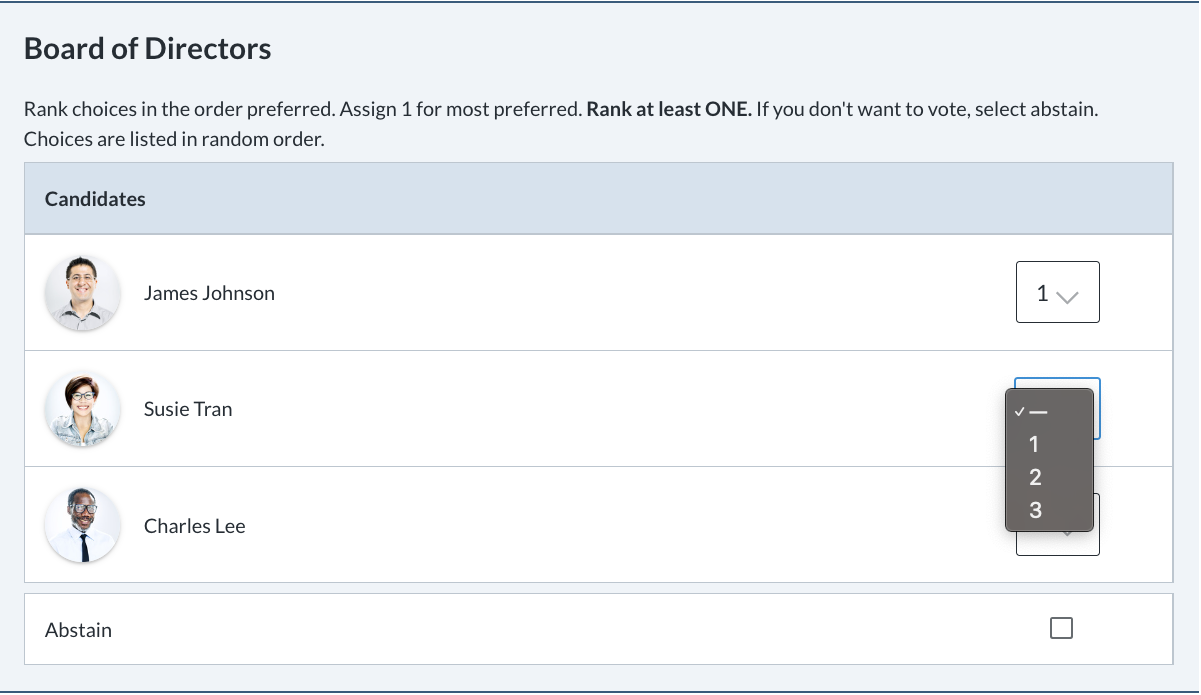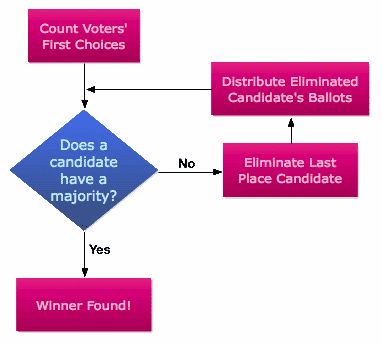Also known as Preferential Voting with Multiple Vacancies

STV voters rank the candidates in order of preference, with “1” being the highest (most preferred) ranking. For example, if there are three candidates in local government elections, the voter places “1” beside their first choice, “2” beside their second choice, and “3” beside their third choice. A vote quota is generated and once a candidate meets the quota, their surplus votes are transferred to another candidate in the election. The first candidate to meet the quota is elected when using the single transferable voting system. There are several single transferable vote advantages including being able to elect multiple candidates at the same time and transfer extra votes to other candidates so that voter preferences don’t get wasted.
The difference between a regular preferential vote and single transferable vote is the number of vacancies. The basic preferential vote has one vacancy (a single seat); when multiple vacancies exist, STV is used to tally the number of votes. With multiple vacancies, during the tally, surplus votes are “transferred”, based on the voters' rankings of the candidates at the time of voting, in order to ensure that all vacancies are filled. To transfer votes, ElectionBuddy uses the Meek’s STV Method. This system will be explained in more detail in the next section of the article.
When using a single transferable vote, results are calculated through the process of redistributing the votes and eliminating low-ranked candidates in rounds to try and get a candidate across the quota of votes required to become elected.

To generate a quota, the total number of submitted votes in an election is divided by the number of available vacancies for the position plus one. Then, 1/109 is added to that quotient number, and the result is truncated to 9 decimal places. For example, if we have 115 votes cast in an election where the position up for election has three vacancies, the total number of votes a candidate will need to be elected is 28.75 votes.
In the first round of tallying, the first preference on each ballot counts as a vote for that particular candidate. Any candidate who has at least the minimum number of votes required, as dictated by the quota, is automatically considered a “winner”.
If there is at least one candidate who surpassed the quota, then their surplus votes are transferred. If no candidates surpassed the quota, the candidate with the fewest votes is eliminated, and their votes are transferred to other candidates. If candidates are tied for last place, then one candidate is randomly selected for elimination.
The quota number can change if a vote is “exhausted”. A vote becomes exhausted in the event that the voter has not indicated a different candidate to transfer their vote to, or all of their other indicated candidates have already been eliminated. If the voter has not indicated a preference for their vote to be transferred to, then once their final ranked candidate is eliminated, the voter’s vote is eliminated with the candidate. This affects the quota because it affects the numerator of the quota formula: the total number of votes cast is decreasing.
No matter whether the votes are coming from an eliminated candidate or from surplus votes from a candidate above quota, the transferring process is the same. Votes are transferred to the next highest-ranked candidate, as indicated by the voter. However, there is a big difference between transferring surplus votes and transferring votes from an eliminated candidate. When a candidate is eliminated, all of their votes get redistributed to give each candidate a fair chance of representation, but when one candidate has surplus votes, only some of their votes are redistributed. Depending on which votes are considered “surplus”, the outcome for other candidates can change when using a voting system: if two voters indicated a candidate who has surpassed the quota for first place, but their second-choice rankings are different, the outcome for the next candidate could be affected depending on which of the two voters’ ballots are considered “surplus”. To solve this problem, fractions are used to determine the outcome of who gets elected, which keeps the vote distribution fair and unbiased for all candidates running for the local district, council or government seat.
In the above example, imagine a candidate received 32 votes, over 3 greater than the quota of 28.750000001 votes. That candidate has a little over 3 surplus votes to be distributed (32-28.750000001=3.249999999). The surplus votes are transferred at 3.249999999/32, or 0.101562499, of their value to one of the other candidates. After all the votes have been redistributed, 3.249999999 total votes were transferred.
ElectionBuddy uses Meek’s STV system to transfer surplus votes. The candidates who have hit the quota continue to be a part of the receiving and transferring of votes. Each candidate is assigned a keep factor that identifies how many of the votes they receive should be transferred away. So, any candidate under the quota number will have a keep factor of one because they will keep the entire portion of the vote and not transfer anything away. Candidates above the quota will have a keep factor of less than one because their votes will always have a portion transferred away to keep them at the quota. Because the candidates are always getting votes, even if they’ve reached or surpassed the quota, the voter’s votes are always going to their intended candidates, even though a portion of that vote may be transferred away to another member running in the election.
Previously, the STV electoral system was only applied intermittently to determine winners in complex and closely contested polls, such as representation for a government office. Today, this voting system has become popular across the world, with many local, regional, and national governmental electoral bodies and non-profit organizations using it to run important elections through online, digital, and paper ballots. For instance, Australia is currently using various forms of the Single Transferable Vote system to manage elections in different local and regional areas.
All lower house elections in Australia along with those for all states apart from Tasmania, use this voting system. In the state of Tasmania, elections are done using the Hare-Clark voting system. The STV system is also very popular in Canada. A single transferable vote has always been used in the Calgary and Edmonton elections to pick members for the Alberta Legislative Assembly.
Many British Columbia cities, including Vancouver, New Westminster, Nelson, and Victoria, use this voting system for their municipal government elections. Other Canadian provinces that have been using the STV system for their polls include Manitoba, Ontario, and Saskatchewan. This system is also popular in Estonia, India, Malta, Hong Kong, New Zealand, and the Republic of Ireland.
Here is a good example of how to calculate the quota in the single transferable vote. In this single transferable vote example, the total number of valid votes is 109,525, and the local government seat vacancies are three. There are five candidates vying for these government positions: John, Aliyah, Sally, Helen, and Paul. Therefore, the quota number of 109,525 will be divided by four because there are three vacancies, plus one. Plus one equals 27,382. If the candidate named John reaches the quota, he is elected for representation and wins one of the government seats. His extra votes will be transferred based on the instructions on the voter ballot.
If the majority of the voters who chose John as their most preferred candidate also chose Aliyah as their second most preferred candidate, she will get enough of the transferred votes to be elected to one of the government seats. Her surplus votes will also be transferred to Sally, enabling her to win the last representation seat. Helen and Paul got the least number of votes and, therefore, they were automatically excluded, and their votes were transferred to Sally and Aliyah in the respective rounds.
Also referred to as multi-winner ranked-choice voting, the single transferable vote system is a ranked preferential electoral system that uses multiple-member voters. In a single transferable, each voter uses one ballot to rank each one of the candidates. With the single transferable vote system, votes are transferred whenever possible instead of wasting them. Vote transfer is normally based on the preferences and feedback indicated by the voters on their ballots.
This electoral system is mainly used where there are multiple vacancies. The transfer of votes is meant to create proportionality in the poll and allow for consensus-building behind popular candidates. This transfer of votes also prevents wastage of votes, which is a common issue with other voting systems. Other voting systems types, such as the single non-transferable vote, can often lead to voter preferences being minimized when one candidate gets the majority of votes and it is unclear what other candidates the voters wish to elect.
Every voter must choose their most preferred candidate and other secondary preferences when using the STV system. The most preferred candidate will win if they reach the quota in preference voting or an STV election. But if a voter’s first preference is elected above the quota, their vote is transferred to their second preference. A quota is the minimum number of valid votes that a candidate must attain to be elected to a position. This voting process can be done via online, digital, or paper ballot options. ElectionBuddy supports the STV voting system in all these formats. Using an external system, such as ElectionBuddy, will help your election run smoothly
For further details, please visit Reference Meek Rule on Proportional Representation Foundation and Single Transferable Vote on Wikipedia